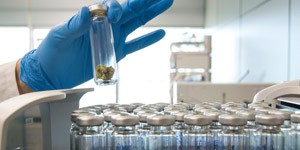By Joan Parés Grahit

Joan Parés Grahit is a medical practitioner. He was born in Barcelona and retired in 2010. In 1974, he graduated in Medicine from the Autonomous University of Barcelona and in 1978, he was certified as a specialist in the respiratory system by the same university.
In the area of medicinal cannabis, he has worked since 2008 in therapeutic attention to members of the La Maca Cannabis Club of Barcelona. From 2010 to 2015 he was a volunteer doctor in the Therapeutic Service Team of CatFAC (the Federation of Cannabis Associations of Catalonia). In October 2015, he became a founding member of the Spanish Observatory of Medicinal Cannabis. In recent years, he has given talks and lectures to associations interested in the recreational and medicinal use of cannabis.
I am now 70 years old and after retiring as a doctor, I spent part of my time working as a volunteer, offering free advice to people who wanted to try using marijuana or cannabis to treat various complaints and to others taking it for non-medicinal purposes who wanted professional advice on usage.
I worked with the CatFAC (a federation of Catalan cannabis clubs), speaking to around 700 people who wanted help and guidance from a health professional. I would ask them to come to a one-hour interview with me and another collaborator who had expertise in this area and was very good at empathising with people who needed a friendly ear. The process continued for around five years, during which time we handed out over 500 personal questionnaires. We are now processing these to get solid statistical data. During this time, we advised over 120 people against medicinal use of the plant.
The people who came to see us brought reliable documents on their clinical background and particularly the drugs they were taking. They wanted us to tell them whether cannabis might be of use to them. Many were grateful for the opportunity to talk to a "normal" doctor on an issue they found difficult to discuss with their regular GP or even with their family and friends. I often felt ashamed by other members of my profession on hearing how they had reacted when patients said they wanted to try marijuana – or had already tried it. One very distinguished physician stood up out of his chair and exclaimed: "We don't prescribe illegal drugs here! Get out!" Others didn't actually advise against their use but just shrugged when the patients asked questions like: "Are there any counter-indications?"; "Where can I buy it?"; "How much?" "How should I take it?"; "Will it affect the medicine I'm already on?"; "Might I have problems with the law?" and so on. In fairness, I must say that I have also met some doctors who took an interest in cannabis therapy –one even organised an information session with some 20-25 doctors and nurses from a public primary health care centre– and a few who are using phytocannabinoids as medicine.
At the end of the interview, wherever appropriate, we issued a medical certificate of cannabis use for medical reasons. This allowed the patients to join one of the clubs in the federation that attended sick people, where there would be experts on hand and suitable strains or by-products of cannabis available. On occasions, some patients have used these certificates to justify possession of marijuana when questioned by the authorities.
When I first began working in this field, I was inspired by the experience of someone very close to me who had clearly benefitted from using marijuana in conjunction with chemotherapy, with no detrimental effects. At that time, I knew nothing about the endocannabinoid system (ES), which was discovered towards the end of the last century.
These days there is no excuse for that sort of ignorance among members of the scientific community, especially health professionals. There are numerous websites containing reliable scientific information, including this one from Fundación Canna, the Spanish Medicinal Cannabis Observatory's site at oedcm.com and the International Association for Cannabinoid Medicines (IACM) at www.cannabis-med.org.
The endocannabinoid system is found in all animals, including humans. It cannot be ignored, since it is one of the systems that modulates cell metabolism. Familiarity with this system enriches the knowledge that any health professional today should have and allows them to optimise their pharmacological arsenal in treating a wide range of pathologies. Provided there are no counter-indications, the phytocannabinoids found in marijuana or cannabis sativa can be useful for treating chronic pain, for alleviating certain spasms and shaking, for inhibiting nausea and vomiting in patients being treated with chemotherapy, for relieving insomnia and for preventing intestinal inflammation and for treating other conditions. And research continues, with laboratory studies holding out some very promising expectations. However, due to the stigma and reputation of the plant, the clinical trials that would be needed to validate or refute these first impressions are not being carried out. Some very interesting research on the anti-carcinogenic effect is being carried out by the SEIC (Spanish Society of Cannabinoid Research www.seic.es).
As I learnt more about this branch of medicine, I also discovered that there are many different types and subtypes of the cannabis plant, which contain over 100 cannabinoids as well as terpenes and flavonoids... When cannabis is being used as a medicine it is essential to know the concentration of the different cannabinoids, especially THC (tetrahydrocannabinol) and CBD (cannabidiol) since they have effects that may or may not be complementary for the symptoms being treated.
Cannabinoids are very safe in the context of clinical applications, but they are not a universal panacea. Their medical use may be restricted by undesired psycho-active effects caused by high concentrations of THC, although these are transitory. CBD has no such effects and indeed, its presence can reduce the unwanted effects of THC.
I also learned that the plant can store significant quantities of toxins and that both the plant and its derivatives therefore need to be analysed to prevent any undesirable effects. It may contain heavy metals from the soil in which it is grown as well as remains of fertilisers and pesticides and/or pathogenic micro-organisms from the cultivation system and subsequent handling. It is essential to be certain of the supplier of the plant or derivative, and demand that they be able to demonstrate the concentrations of different phytocannabinoids and the absence of any dangerous pollutants, based on reliable analyses. I am all in favour of self-growing, either on an individual or shared basis, by users with experience and responsibility who are not driven by economic interests.
In the surveys we carried out between 2011 and 2016, 57% of those consulted were seeking to relieve chronic pain, 12% wanted to alleviate secondary nausea and vomiting in treatment with chemotherapy and immunotherapy, 12% used it to recover the their appetite, 7% to treat the symptoms of multiple sclerosis and 12% to mitigate problems arising from other pathologies (psoriasis, ulcerative colitis, epilepsy, etc.). The age of those using cannabis for medicinal purposes ranged from 20 to 84, though the majority were in the 40-60 age group. The sexes were fairly evenly represented (53% male and 47% female). Of those surveyed, 35% had used cannabis occasionally before, 31% had it used it habitually and 34% had never used it.
Most of those surveyed were unaware of other forms of consuming marijuana apart from smoking it in a "joint", with or without tobacco. However, this is not a recommended form of use, given the inevitable poor combustion which creates harmful by-products, including solid particles from the paper, tobacco and the grass itself; polycyclic aromatic hydrocarbons and gases such as nitric oxide, carbon monoxide, etc. In large enough doses, all of these by-products can cause irritation in the mucous membrane of the mouth, throat and respiratory tracts. Furthermore, when cannabis is smoked, between 60% and 70% of cannabinoids are lost in unabsorbed smoke. Cannabis vaporizers have been available for some years now. There are many different apparatuses on the market but few are reliable. In good vaping, all the cannabinoids are made available with none of the toxins caused by smoking. Vaping provides a NOx-free experience, rich in cannabinoids. In addition, the cannabis vapour does not contain derivatives of tar and therefore does not remain in the air or stick to clothing.
Reliable studies on vaping show that different cannabinoids have different vaporization temperatures. People wanting a sedative effect should vaporise the cannabis at 190º/200ºC to obtain the most relaxing cannabinoids. To obtain psycho-active effects, the cannabis should be vaped at 150º/160ºC. On advantage of this form of use is that the vapour can be humidified up to 50º/60ºC, thus preventing dryness of the mucous membranes.
Other ways of using phytocannabinoids include infusing them in milk or dissolving them in butter to make biscuits, cakes, etc., tinctures, oils, locally-applied creams, etc. When taken orally, it takes much longer to absorb than via the respiratory system, and it depends on variables such as the accompanying food, proper functioning of the digestive system, etc.
For the effective treatment of certain illnesses and pathological symptoms such as some forms of epilepsy, ulcerative colitis, chronic intense pain, etc., oils are generally used with a high CBD and low THC concentration. These are obtained using sophisticated laboratory apparatuses and techniques that add to the price, making the products almost prohibitive for people on modest budgets. Savings on other drugs might well make the use of cannabinoid oils a cost effective option for the public health system, if doctors in the system knew how to prescribe them properly.
The people I have met who use cannabis do so for three purposes: recreational use, medicinal use and what I call "maintenance use" for their everyday wellbeing. In the first case, usage is occasional and the preferred cannabinoid is THC, which distorts the sense of time and space and augments the user's sensitivity and perception of sound, smell, touch and sight, especially the intensity of colours. It has an intoxicating effect. These are the effects that some people seek and others try to avoid. Cannabis can also augment creativity in artistic activities and facilitate introspection. Some "psychonauts" particularly like the high caused by the entheogenic substances. Recreational use is confined to clearly delimited moments: at the weekend, at night, in some romantic moment... There are no complications provided it is used knowingly; it does not even cause withdrawal symptoms. Withdrawal syndrome occurs in people who consume cannabis constantly, every day, for months on end and then give it up suddenly. The result is increased irritability, anxiety and even some depression, though this tends to disappear after a few days. The withdrawal symptoms of marijuana are mild when compared to tobacco, alcohol or other substances.
What I call maintenance use for everyday wellbeing consists of consuming small quantities of cannabis on a daily basis – not as a special treat but to relax at the beginning or end of a normal day or to cope with some problematic meeting, etc. The idea is to attain a feeling of wellbeing without seeking any other effect than a gentle physical and/or mental relaxation which relieves the anxiety caused by certain stressful situations in the past or present. In this type of use, it is necessary to be aware of the tolerance effect; over time, larger doses may be needed to obtain the same effects. This effect has been demonstrated for THC but does not occur with CBD. To relieve the tolerance effect, users are recommended to spend periods without taking it and to change the varieties they use. Just as music is meaningless without silences, the beneficial effects of "maintenance" cannabis use are augmented by periods of abstinence.
As for medicinal use, it should be noted that in conventional medicine, the science of pharmacology has evolved to measure, define, and study substances through rigorous statistical analyses, clinical trials and established protocols. The phenomena under scrutiny are analysed logically and experiments are proposed to validate or refute the hypotheses. In other words, the process involves a pro-experimental exercise of phenomenological empiricism. In the case of cannabis, it is particularly disheartening to see that while this work is being scrupulously carried out in the laboratory on animals and on human tissues, it cannot subsequently be followed up with clinical trials on human subjects with the same rigour, due to the prejudices of the relevant authorities and despite scientific evidence of laboratory research. In this regard, it is important to highlight the enormous work being carried out by SEIC (as mentioned above) and ICEERS, a foundation linked to the ethnobotanical and social and cultural study of plants with medicinal uses (www.iceers.org).
The term 'therapeutic cannabis' is often used as a synonym of medicinal cannabis. However, if we examine the etymology of the word 'therapeutic' we see it comes from the Greek therapeutikós which refers to the act of caring for, waiting on or facilitating the wellbeing of those who request it. In this strict etymological sense, all three kinds of cannabis use –recreational, maintenance and medicinal– can be therapeutic if the plant is used properly. This means:
- There must be no counter-indications such as arrhythmia of the heart, serious mental illness, simultaneous use of incompatible substances or medicines, etc.; it must not be used by minors;
- Only plants or by-products of proven quality should be used, with a known cannabinoid concentration. The so-called black market should be avoided;
- The dose should be adjusted to match the specific effects sought on each occasion;
- The place and company for consuming the cannabis should be chosen intelligently.
If it is to be used for medicinal purposes, it is highly recommended that the patient's regular doctor or therapist should be informed so that they can decide on the best clinical course of action.
There are many prejudices about the cannabis plant. These are the product of ignorance or, worse still, disparagement of the unknown. It is not appropriate at this time to discuss the use of cannabis with people who do not know or do not want to know what the endocannabinoid system is and what its functions in the human body are. Some supposedly eminent professors pontificate on the ineffectiveness of herbal therapy with marijuana because they are serving the economic interests of large pharmaceutical companies. In doing so, they are deprecating the proven benefits of proper use of the plant with a well-documented therapeutic-medicinal record going back millennia.
Finally, I would like to discuss the need to take a fresh look at the whole concept of addiction. In some media, addiction has been likened to a disease. This is a serious mistake. Addiction is beneficial, provided it does not harm the person with the addiction. It is as real as the force of gravity. It is an exercise of personal freedom. Our lives would be inconceivable and unbearable without addictions. Only the dead have no addictions. The important thing is to know how to manage them. Who can say they are not addicted to some type of food – bread, chocolate, wine or sugar...? Or to certain activities – listening to music, sex, work, making money, practising sport...? Or to certain feelings: love, friendship, fame, vanity...?
Anyone who claims not to be addicted to anything is either a liar, a hypocrite, an ignoramus or a zombie. In itself, a car is not dangerous; the danger lies with the driver who out of recklessness or ignorance can turn his use of the vehicle into a hell for himself and others. Similarly, if you know how to use cannabis properly, there is nothing bad about it. The best way of making good use of the plant is by gaining knowledge and familiarity, not through that prohibition so favoured by rigid, anachronistic minds.


